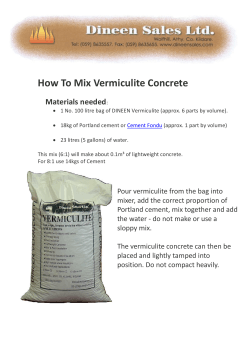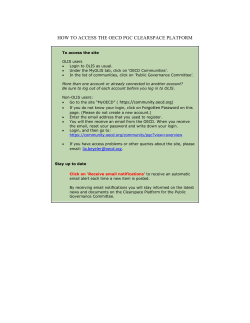
WHAT IS A KNOWLEDGE-BASED ORGANIZATION? Theme: Zack, Michael H.
Organizational Learning and Knowledge th 5 International Conference th Friday, 30 May – Monday, 2 nd June, 2003 WHAT IS A KNOWLEDGE-BASED ORGANIZATION? Theme: Strategy, Competitiveness and Learning Zack, Michael H. Northeastern University Contact author: Zack, Michael H. Northeastern University College of Business Adminstration 360 Huntington Avenue 214 Hayden Hall Boston, MA US 02115 Telephone: 617.373.4734 E-mail: M.zack@neu.edu OLK5 -1- OLK5 Abstract Knowledge-based organizations (KBO) are usually considered to be those whose product or service is knowledge-intensive. The characteristics of a KBO, however, go beyond product to include process, purpose and perspective. Process refers to an organization’s knowledgebased activities and processes. Purpose refers to its mission and strategy. Perspective refers to the worldview and culture that influences and constrains an organization’s decisions and actions. KBOs exhibit knowledge-intensive processes, purpose, and perspective, regardless of their product. This article compares two organizations, one providing industry research and the other cement. The cement company is shown to be more knowledge-based than the research company when these additional characteristics are taken into account. Introduction Consider the following two companies: Technology Research Group (not their real name) is a leading provider of research and analysis in the information technology hardware, software and services industry (Zack 1996). Knowledgeable analysts, each specializing in a particular industry segment, forecast the economic state of their segment by continually monitoring news and economic activity and conducting surveys and interviews of key industry participants. Based on judgment and experience, they interpret the story behind the numbers to create a plausible future scenario. The results are published as a series of research reports. Holcim Ltd. is one of the world’s largest suppliers of cement, aggregates (gravel and sand) and concrete (Holcim 2002). Cement, Holcim’s primary product, is a powder that acts as the binding agent when mixed with sand, gravel or crushed stone and water to make concrete. Cement is made by mechanically crushing, grinding, and milling limestone and then baking it at very high temperature. The equipment is similar to the food grinder and oven found in a typical kitchen. The process has remained essentially unchanged since its discovery just over 100 years ago. Which company is a knowledge-based organization? If one applied the traditional criteria used by most of those who study and write about knowledge-based organizations (KBOs) (e.g., Starbuck 1992), one would probably pick TRG. KBOs (also often referred to as knowledge-enabled or knowledge-intensive organizations) are usually described in terms of the knowledge intensity of their product or service. The greater degree to which knowledge forms the core of the product or service, the more knowledge-based the organization. However, using products or services as a means for categorizing or defining the knowledgebased organization is inadequate. Products and services reflect only the observable and tangible parts of an organization. The primary resources that enable an organization to produce are hidden within the so-called “invisible assets” of the organization (Itami 1987) – its knowledge about what it does, how it does what it does, and why. The characteristics of a KBO go beyond product to include process, purpose and perspective. Process refers to the activities within an organization, some of which are directly involved with producing a product or service and others that are ancillary but no less important. Purpose refers to the mission and strategy of the organization – how it intends to profitably OLK5 -2- OLK5 provide products and services to its customers. Perspective refers to the worldview and culture that influences and constrains the decisions and actions of an organization, including how it views itself and its strategic mission. Each of these forms a basis for evaluating the degree to which knowledge is an integral part of the organization and the way it competes. Process and knowledge Consider the processes that directly result in creating product. All companies face the issue of choosing from an infinite number of possible ways to combine their resources and activities to produce their products or services (Romer 1992). While some are obvious, there remains much room for less obvious alternatives; many more than can be tried one-at-a-time or perhaps even identified. The way that companies narrow the combinations to those providing the greatest expected value is by knowing something about which combinations seem to work the best – or at least knowing enough to get a better starting point than competitors. The key role of knowledge then, is in knowing how to configure and integrate resources such as raw materials, machinery, energy, labor, etc. – most of which are commonly available to all – and apply them in ways that serve customers better than can one's competitors. Even though some organizations face greater physical constraints on how they can apply their resources than others, knowledge still plays an important role regardless of what the organization does. The KBO recognizes this and, more importantly, seeks to manage it. On the surface, TRG would still seem to be more of a KBO than Holcim, given the degree of freedom it has to segment the industry, assign analysts to industry segments, and apply various approaches to analyzing and manipulating the information it gathers. Holcim is much more constrained. There are only so many ways to grind rock. The key, though, is what the company does about its knowledge. A physically constrained company can be more knowledge-based than one dealing with fully unconstrained intellectual matter if it takes the role of knowledge seriously and does something about it. The process of managing knowledge Stepping back from direct product realization processes, consider the underlying processes that help create and apply the knowledge required to deliver the product or service. Most organizations are focused on the concrete and observable activities that make up what they do on a day-to-day basis. But if knowing how best to configure resources and activities is key to outperforming the competition, then an effective KBO is one that manages this knowledge well. The realm of knowledge management addresses two related processes: applying existing knowledge effectively, and creating new knowledge (Zack 1999b). One of the challenges for organizations is to apply what one part of the organization knows to activities taking place in another part of the organization. Similarly, knowledge needs to be shared over time so that an organization can benefit from past experience and avoid repeating their mistakes. For example, Holcim might benefit from applying a manufacturing innovation in a particular cement processing plant to similar plants around the world. OLK5 -3- OLK5 An even greater challenge is enabling the right people from various parts of an organization to share and combine what they know to create new knowledge. In TRG’s case, this would mean, for example, analysts sharing what they know about growth drivers in different but related industry segments, or attempting to create and test a model of how sales in one segment (e.g. PCs) related to sales of the other (e.g. peripheral devices). Finally, the most valuable processes are those that provide opportunities and incentives for proactive experimentation and learning, for example Holcim trying a new cement manufacturing process or TRG developing a new industry research segment. How well did the two companies mange their knowledge? TRG tracked dozens of different industry segments. Each segment was organized as its own small, autonomous profit center. While this did much to encourage an entrepreneurial spirit within each segment, it did little to help TRG leverage its knowledge resources. Each analyst team used a somewhat unique approach to gathering and analyzing market information. Each used a different technology and format to capture and store raw data, analysis, interpretation and final reports. The content and structure of the reports tended to vary and even the names of the lines of business were not standardized. If there is one constant in the information technology industry, it is pervasive, rapid and relentless change. The most prominent form of change other than outright technological obsolescence was convergence. For example, TRG might be tracking markets for groupware, web portals, networking, and document management as separate businesses and research areas. Along comes “knowledge management” and an opportunity to combine portions of those existing segments into a new virtual segment with a healthy market demand. However, TRG found this difficult to do technically, informationally, and politically. It didn’t leverage the opportunity to share tips and techniques for gathering and analyzing information among its research areas. Most importantly, it missed opportunities for combining its industry knowledge in new and valuable ways to create new products or reach new markets. When it came to managing knowledge, TRG was not a KBO. What about the cement company? Holcim, in contrast to TRG, explicitly regarded knowledge as its key resource and learning as its key capability. Holcim operated over 100 cementmanufacturing facilities, 240 quarries and 600 mixed concrete facilities in over 70 countries (El-Osta et al 1998, Holcim 2002). Like TRG, Holcim operated in a highly decentralized manner, its country managers enjoying significant autonomy. However, Holcim regarded the exchange of knowledge and expertise as the glue that held the company together. They created an internal group, Holcim Management and Consulting (HMC), to develop, identify, transfer, and apply strategic knowledge among all its entities worldwide. To indicate its strategic importance, HMC reported directly to the Executive Committee. In addition to facilitating interaction among managers worldwide, HMC itself became a repository of knowledge, expertise and best practice that it shared and reapplied by consulting to the various Holcim entities. For example, energy is the greatest cost of producing cement, and HCM helped plants improve process efficiency. Holcim’s need to reduce CO2 emissions placed a premium on learning more about the use of alternative fuels. Product innovation (possible even with cement) relied on experimenting with various admixtures to vary and improve the properties of cement for different applications. Even though it made cement, Holcim was clearly managing knowledge as a KBO. OLK5 -4- OLK5 Knowledge and its management is important to any organization, even those making cement, bricks and other products of ostensibly low-knowledge intensity. A KBO takes knowledge seriously regardless of what it makes or does. A company needs to know some things even to make cement. The more they know relative to their competitors the better chance they have of outperforming them. Purpose: strategy and knowledge Having considered product and process, I proposed that processes, especially those directly tied to knowledge, are a much better indicator of a KBO. But even a highly effective set of knowledge management processes does not guarantee that an organization will perform well or better than its competitors. Consider how many dot-coms with wonderful knowledge sharing cultures and processes went out of business at the close of the millennium. While managing knowledge right is useful, managing the right knowledge is crucial. And strategic knowledge can take a long time to develop. If it didn’t, it wouldn’t be strategic. This is great if you are smarter than your competitors; it can be a death sentence if you are not. Companies that are successful over the long term are those who align their knowledge management processes with their strategy. The true KBO thinks of its strategy - its means for competing and surviving over the long term - in terms of knowledge. It recognizes that knowledge is a key strategic resource, and asks the questions • What do we need to know to formulate and to execute our desired strategy? • What strategies can we successfully execute given what we do know? • What do we currently know? • What do our competitors know? (Zack 1999a) The gap between what an organization knows and needs to know is an internal knowledge gap, in a sense representing the strengths and weaknesses of a “Knowledge–SWOT” analysis. The gap between what it knows and what its competitors know is an external knowledge gap. It represents the opportunities and threats of a Knowledge-SWOT analysis. Organizations must focus their knowledge management efforts on their internal and external strategic knowledge gaps, today and for the future. And they must be able to close those gaps via effective organizational learning faster and more effectively than competitors (Zack 1999a). Holcim clearly recognized the strategic nature of its knowledge. Given its strategy to provide the best quality and most innovative cement-based products using the most efficient, sustainable and environmentally friendly processes, it engaged the hearts and minds of its entire organization in managing the knowledge and learning to support that strategy. TRG did not. Perspective: Taking a knowledge point-of-view The final test of a KBO requires examining the organization’s fundamental point-of-view regarding knowledge. The true KBO takes knowledge into account in every aspect of its operation. Not only does it evaluate its strategy in terms of knowledge, but it treats every activity as a potentially knowledge-enhancing act. It uses knowledge and learning as its OLK5 -5- OLK5 primary criteria for evaluating how it organizes, what it makes, who it hires, how it relates to customers, the image it projects, and the nature of its competition. Many KBOs I have studied have made a significant transition in perspective by redefining their fundamental mission from one based on the more traditional products and services to one based on knowledge. For example, World Bank, formerly a developmental lending institution, now refers to itself as the “knowledge bank.” This is not mere window dressing. World Bank has gone to great lengths to understand and manage the role of knowledge and learning in reducing world poverty. It realized that just supplying development funds was not an effective solution. It has invested in and reorganized around knowledge creation and sharing activities. Money is now just an adjunct to that mission. Similarly, Lincoln National Re (recently acquired by Swiss Re) transformed itself from selling reinsurance to knowledgebased risk management. Its strategy, organization structure, technology infrastructure and core processes are all focused on creating and maintaining the strategic “knowledge platform” from which it derives its innovative risk management products and services. Holcim regards knowledge as the "glue" that holds that globally distributed company together. Clearly its perspective regarding knowledge is far more developed and ingrained than TRG's. The KBO revisited As the comparison of TRG and Holcim shows, even cement companies can be knowledgebased organizations, while companies selling knowledge-intensive products may not be at all. The KBO lives and breathes knowledge. From day-to-day operations to long-term strategy, creating and applying knowledge is always in the forefront. Any organization can be knowledge-based, regardless of the product or service it produces as long as it takes knowledge seriously. This requires managing its knowledge creation and sharing processes, formulating its competitive strategy with knowledge in mind, and regarding knowledge in every decision it makes. Bibliography El-Osta, D., Garcia Perez, J., Hutchinson, L. and Yakpo, K. (1998) Holderbank: A Faster Learning Organization. European Case Clearing House: Haute Etudes Commerciales, Univeristy of Geneva, Switzerland. Holcim: www.holcim.com Itami, H. (1987) Mobilizing Invisible Assets. Harvard University Press: Cambridge. Romer, P. M. (1992) Two Strategies for Economic Development: Using Ideas and Producing Ideas. Proceedings of the World Bank Annual Conference on Development Economics, 63-91 Starbuck, W. H. (1992) Learning by knowledge-intensive firms. Journal of Management Studies, 29(6): 713-740 OLK5 -6- OLK5 Zack, M. H. (1999a) Developing a Knowledge Strategy. California Management Review, 4(3): 125-145 Zack, M. H. (1999b) Managing Codified Knowledge. Sloan Management Review, 40(4): 45-58 Zack, M. H. (1996) Electronic Publishing: A Product Architecture Perspective. Information & Management, 31(2): 75-86 OLK5 -7- OLK5
© Copyright 2025












